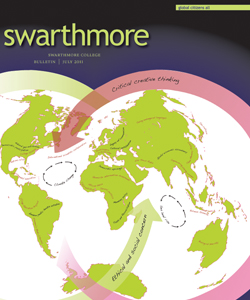Global Academic Interests
Easily International
 Catching up with evolutionary developmental biologist Scott Gilbert this spring wasn’t easy, as he zipped back and forth between his two labs—one at Swarthmore, the other in Helsinki. “I spend two weeks every two months in Helsinki in the spring. The rest of the time, we Skype,” he says.
Catching up with evolutionary developmental biologist Scott Gilbert this spring wasn’t easy, as he zipped back and forth between his two labs—one at Swarthmore, the other in Helsinki. “I spend two weeks every two months in Helsinki in the spring. The rest of the time, we Skype,” he says.
Gilbert, the Howard A. Schneiderman Professor of Biology, established the Finnish connection during a sabbatical leave in 1990–1991. “There was a researcher in Helsinki who was about to retire, and I really wanted to work with him,” he says. Gilbert took his sabbatical a year early and the College made up the difference between a research grant he’d received from the National Science Foundation and his Swarthmore salary. “The beneficence of the College was critical in my starting these international interactions,” he says.
Gilbert enjoyed working with young Finnish researchers in the early 1990s so much that, encouraged by the Finnish biologists, he applied, successfully, for a newly established Distinguished Professorship Grant, which provided salaries for himself, a technician, and postdoctoral or pre-doctoral researchers—and thereby opened the door to research collaboration between Swarthmore and the University of Helsinki.
For two years, the research groups have been exploring how the turtle forms its shell, looking at the formation of the bones and sutures (connections between the bone segments) in the ventral (underside) shell. Gilbert and his partners have discovered that the bones form from the same group of cells that form the bones of the human face and skull.
“This means that we can use the turtle’s shell as a model for mammalian face and skull bones—their formation, diseases that afflict them, and why the molecules work to form sutures between bones rather than one big bone. How is cell proliferation controlled so tightly that one side of the face is a mirror-image of the other? Nobody knows.” Yet.
A second project investigates the formation of the scutes (scales) of the turtle’s shell, which must coordinate their growth with each other and with the growing bones.
“These are exercises in evolutionary developmental biology,” Gilbert says of the research, which probes how changes in embryonic development can create new anatomical structures. “We’re currently writing a paper started by one of my honors biology students at Swarthmore and being completed by post-docs in Helsinki,” Gilbert adds. They also plan to submit to an international journal an article that originated in Finland but includes the research results of three Swarthmore co-authors. In June, some of the Finnish group spent two weeks working in Gilbert’s Swarthmore lab.
FACTOID: Every academic department in the College offers courses that have a global reach, including those in the natural sciences, where ideas have always had no borders.
 Email This Page
Email This Page